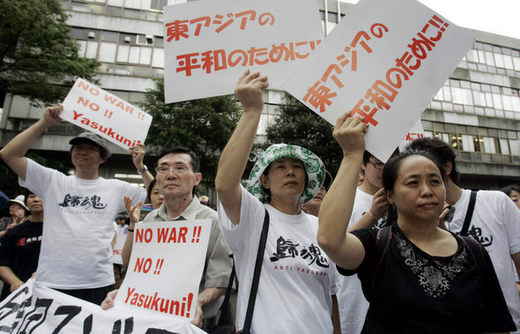 |
|
Protesters from Korea, Japan, and Taiwan rally just after Japanese prime minister Junichiro Koizumi’s pilgrimage to Yasukuni Shrine on August 15.
|
S.K., Taiwan, Japan among those involved in demonstrations
After Japanese Prime Minister Junichiro Koizumi went ahead with his planned visit to Yasukuni Shrine on the morning of August 15, a day which commemorates independence from Japanese rule for many citizens of Asia, citizens of South Korea, Taiwan, and Japan continued their protests in Japanese cities such as Tokyo and Osaka The groups had rallied for about five days in order to try to stop Koizumi’s intended visit to the shrine, which memorializes Japanese war dead - including Class A war criminals - as well as citizens of other Asian countries forced to serve in the Japanese military. About 400 members of the Joint Committee Opposed to the Yasukuni Shrine, formed by civic organizations from the three nations, began a rally at a park in Tokyo at 8 a.m. yesterday, shortly after the prime minister visited Yasukuni.Lawyer Tzuguo Minamuri, the leader of the Japanese faction of the group, said, "We couldn’t stop him because of our lack of power, but we are ready to fight together with more Asian friends to stop the Japanese prime minister’s visit to Yasukuni." After the park rally, participants held a one-and-a-half hour protest march in Tokyo. The protesters wrapped up their five-day struggles by holding their final rally of the day at Hibiya Park, a major park in downtown Tokyo. However, Minamuri said, it is clear that this is not the end of the problem. A committee member said, "We waged protests to make sure that their won’t be only individual reaction any longer regarding the Yasukuni Shrine matter. Our rallies have been a starting point for joint counteractions by civic groups of South Korea, Taiwan, and Japan in order to attract further international response," added the member. The committee said it would to intensify its efforts to win a lawsuit that would cancel the unauthorized enshrinement of those at Yasukuni. A Taiwanese citizen and eight Japanese citizens have filed the lawsuit against Yasukuni with the Osaka district court on Aug. 11. Now, families of South Koreans enshrined there without permission plan to follow suit, this time at Tokyo district court. Discussion is underway to organize a joint lawsuit, involving plaintiffs from all three countries. In June 2001, survivors and families of South Korean soldiers and civilians forcibly drafted into the military filed a similar lawsuit against the Japanese government in connection with the war shrine, but the Tokyo district court rejected the case, saying that the matter of enshrinement is under the responsibility of the independent committee that runs Yasukuni Shrine, not the government. In response to the ruling, the committee has proceeded with filing a lawsuit against the nongovernmental group that runs Yasukuni Shrine for honoring a Japenese god of war alongside the mortuary tablets of their family members. The committee will perform fact-finding missions to discover the number of South Korean and Taiwanese citizens enshrined at Yasukuni and what role the Japanese government played in the enshrinement, as neither the committee that runs Yasukuni Shrine nor the Japanese government have been forthcoming with the information. The committee is mulling the referral of the Yasukuni Shrine issue to the U.N. Human Rights Council. Additionally, the three-nation committee said it would seek the support of religious communities, including the Vatican, to inform the greater international community about the problems surrounding Yasukuni Shrine. As well, the group seeks cooperation with international human rights organizations on the matter. The committee says it hopes to make the international community how unauthorized enshrinement at Yasukuni is a human rights abuse, in the hopes that international bodies will be able to exert pressure upon Japan to resolve the issue.






